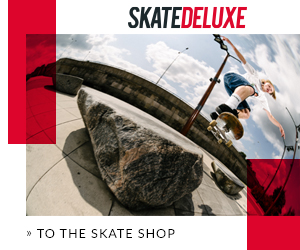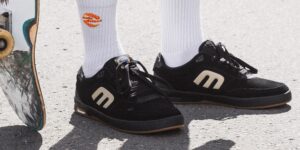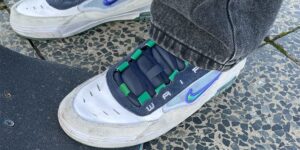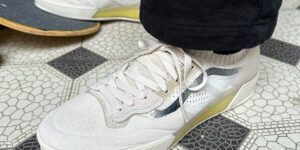- 1. General Info
- 2. Size Recommendation
- 3. Skateboard Technologies
- 3.1 7-Ply
- 3.2 8-Ply
- 3.3 Impact Support
- 3.4 Impact Light
- 3.5 Featherlight
- 3.6 True Fit Mold
- 3.7 Resin-7 Epoxid (R7)
- 3.8 Resin Hardrock
- 3.9 Resin Hybrid Maple
- 3.10 R1
- 3.11 Heavyweights
- 3.12 Low Pro II
- 3.13 Shaped vs. Full Shaped Skateboard Decks
- 3.14 Everslick
- 3.15 Real Slick
- 3.16 Powell-Peralta Flight Deck
- 3.17 Santa Cruz Powerply
- 3.18 Santa Cruz VX
- 3.19 Cold Press
- 3.20 POP SECRET
- 3.21 7-Ply Birchwood
1. Skateboard Decks: General Info
Which skateboard deck is right for me? What should I know before buying a deck? What separates the different types of decks from each other? What effect does my shoe/body size have? You can find answers to all these questions and more here!
You’re looking for a skateboard for your daughter or your son? Here you’ll get all infos on how to choose the best skateboard for your kid:
Skateboards for KidsThroughout the history of skateboarding, decks have gone through many phases of development and changes. Today there are decks suited especially for particular terrains, with specific widths, lengths, shapes and special construction technology.
Most decks are made out of North American maple wood, which due to its slow growth, is particularly durable and stable.
Traditionally, seven layers of maple wood interlaid with a water-based glue or special epoxy resin are pressed together under high pressure in order to create a skateboard deck.
The size of decks is almost always measured in the American unit of inches. One inch corresponds to the European unit of measurement of 1 Zoll, which is 2.54 cm.
1 Inch = 2.54 cm
1.1 Skateboard Decks: Construction & Size
Normally, a skateboard is 28”-33” (70-80 cm) long.
The board is divided into three parts: the nose (front), the wheelbase (between the trucks) and the tail (rear). o find out which end is the front and which the rear, take a closer look at your deck. The nose is usually slightly wider and steeper than the tail.
Tip: The design of the deck can also help distinguish the nose from the tail end. Most graphics are designed so that the nose is the top, or left, respectively.
The nose and tail are the rounded ends of your deck, which are more or less steeply curved upward. There are also flatter and steeper designs based on the type of board. The theory is that steeper nose and tail ends lend more pop to your deck because of the increased leverage. In contrast, a flatter nose and tail provide a better board feel.
Pop = the effect of kicking the tail of the board against the ground in order to propel the board upwards and become airborne
The wheelbase is normally 12”-15” long and not only impacts the overall length of the board but also how it handles. Simply put, the shorter the deck, the agiler it feels, and the longer the deck, the smoother and more stable it feels.
2. Wheelbase
3. Nose
4. Tail
1.2 Skateboard Decks: Concave
Concave refers to the longitudinal curvature of the deck. The higher this curvature, the more pressure you can put on the edges of your deck, which improves the steering and enables you to flip your board more easily. Skateboard decks are usually distinguished between low, medium, or high concave. You can decide which level is most comfortable for you by trial and error. We’d recommend beginners to start with a medium concave skateboard deck.
Unfortunately, manufacturers reveal very little information about their decks’ concaves. Therefore, a medium concave by brand “x” can turn out to be very different from the medium concave of another brand. Due to deviations and variances during the manufacturing process, you can’t assume that the concaves of two similar decks will be 100% identical.
2. Medium Concave
3. High Concave
Low Concave:
Low concave skateboard decks have just a slight curvature. This allows for a more stable ride, but also hinders agility. Low concave decks are also more difficult to flip.
Medium Concave:
Medium concave decks provide a compromise between low and high concave decks. If you’re not sure which concave level would suit you the best, you can’t go wrong with a medium concave. The majority of skateboard decks are medium concave.
High Concave:
High concave decks have a very pronounced curvature, which makes the board more agile and easy to flip. However, high concave decks aren’t nearly as forgiving of errors as medium or low concave decks.
1.3 Skateboard Decks: Shape
Street skating, bowl, vert, and cruising all place different demands on a skateboard deck. For this reason, different shapes have been developed to best suit the respective requirements.
1. Classic Popsicle Shape (Street Skateboard Deck)
2. Old School Pool / Bowl Deck
3. Modern Shaped Deck
Street Skateboard Deck
A standard deck shape for street and park skating is the Twin-Tip. This means that the nose and tail are virtually the same shape so that you can easily ride switch. When it comes to the form of skateboard decks, this so-called “Popsicle Shape” has been the standard for years.
switch = The position when you’re riding forward, but the foot that would normally be on the tail, is on the nose. Essentially, the rider is “switching” his or her stance from regular to goofy (or vice versa), which is not to be confused with riding fakie. Fakie describes riding backwards, with the tail facing the direction of movement while your feet don’t change position.
Pool / Bowl Deck:
Skateboard decks for transition skating are almost always a bit wider. Here you’ll normally find decks with a width upwards of 8.25”. In addition to the normal but broader street skateboard shapes, there are also decks reminiscent of old school skateboards. These are now commonly referred to as “shaped decks.”
Shaped Decks:
Shaped decks have established themselves in recent years as a hybrid form of new school street decks and old school pool decks. These decks were originally developed for transition skaters who also wanted to enjoy the occasional street session. Thanks to their pronounced concaves, as well as curved noses and tails, you not only have the perfect transition board, but also the possibility to skate the streets and still do tricks.
Hint: If you’re just starting to skate and want to learn tricks we would recommend a classic popsicle deck.
Cruisers:
Many different types of materials are used to make cruisers. In addition to the traditional pure maple, bamboo can also be combined with maple or even used exclusively. There’s also the famous cruiser made of plastic, better known by its name “Pennyboard.” Besides the Penny brand boards, Bureo, SK8DLX, Anuell, Globe, and Diamond also make plastic cruisers.
Cruiser skateboards also differ in length, width and shape. The special thing about them is the softer wheels and easy manoeuvrability. Thus they are perfectly suited for cities, to get you from point A to point B. They typically have a small curved tail and a flat nose. Cruisers are generally already fully assembled and “Ready to Skate.” If a longboard is too large for you, or just isn’t your cup of tea, then a cruiser is the right choice for you.
2. Skateboard Decks: Size Recommendation
The decisive factor in choosing a skateboard deck usually is its width. Beginners, in particular, may find it difficult to decide on the perfect deck width. If you’re not sure what width suits you best, your shoe size and height are good indicators. By trying out different sizes and getting a feel for your board, you’ll find out what’s most comfortable for you. Therefore, we’ve assembled a few recommendations for you to make the selection a little bit easier.
How skateboard deck width influences riding performance
One of the fundamental factors is that wider boards offer a smoother ride at high speeds. However, they are also heavier, which makes them a bit harder to flip so you’ll need more power in your legs. On the other hand, the wide surface provides plenty of space for catching the board, which can be an advantage when landing tricks. So if you’re into gaps, transitions or just going full speed, a wider board might be right for you.
Contrary to wide boards, narrow boards are lighter and easier to flip. Especially for beginners, this can be an advantage because you’ll need less power to learn your first tricks. However, narrow decks can be hard to control at high speed and have less space to catch and land on. Therefore, narrow decks are ideal for technical skateboarding like doing combos on curbs or on flat ground.
Little hint: We’ recommend a narrow deck for learning flip tricks as a beginner.
How skateboard deck length comes into play
Next, to the width, you’ll also find the deck length in our product descriptions. In order to hold the balance on your skateboard, we suggest that you use your height as a point of reference. You’ll find more information about that in paragraph 2.2.
Regardless of special shapes, wider decks are also typically longer. Of course, they perform a bit differently as compared to shorter decks. While short decks are easier to spin or rotate horizontally, like with 180s or Shove-Its, longer boards provide a bit more surface to catch and make landing easier.
Tip: A long board with short legs isn’t usually a fun combo since it’ll be hard to pull your front foot all the way up to the deck’s nose. So if you’re not that tall, it’s probably best to get a shorter board.
Note: Of course, all our tips are just recommendations that you don’t have to abide by. As a matter of fact, you’ll get used to any new deck pretty quickly.
2.1 Shoe Size
Another means of finding the correct deck width is by using your shoe size. Simply put: The bigger your shoes, the wider the board should be.
| shoe size US | shoe size EU | shoe size UK | deck width |
|---|---|---|---|
| US 4 | EU 36 | UK 3.5 | 7.5″ – 7.875″ |
| US 4.5 | EU 36.5 | UK 4 | 7.5″ – 7.875″ |
| US 5 | EU 37.5 | UK 4.5 | 7.625″ – 8″ |
| US 5.5 | EU 38 | UK 5 | 7.625″ – 8″ |
| US 6 | EU 38.5 | UK 5.5 | 7.75″ – 8″ |
| US 6.5 | EU 39 | UK 6 | 7.75″ – 8.125″ |
| US 7 | EU 40 | UK 6 | 7.875″ – 8.125″ |
| US 7.5 | EU 40.5 | UK 6.5 | 7.875″ – 8.25″ |
| US 8 | EU 41 | UK 7 | 8.00″ – 8.25″ |
| US 8.5 | EU 42 | UK 7.5 | 8.00″ – 8.25″ |
| US 9 | EU 42.5 | UK 8 | 8.00″ – 8.375″ |
| US 9.5 | EU 43 | UK 8.5 | 8.00″ – 8.375″ |
| US 10 | EU 44 | UK 9 | 8.125″ – 8.5″ |
| US 10.5 | EU 44.5 | UK 9.5 | 8.125″ – 8.5″ |
| US 11 | EU 45 | UK 10 | 8.25″ – 8.5″ |
| US 11.5 | EU 45.5 | UK 10.5 | 8.25″ – 8.625″ |
| US 12 | EU 46 | UK 11 | 8.375″ – 8.625″ |
| US 13 | EU 47.5 | UK 12 | 8.5″ – 8.625″ |
| US 14 | EU 48.5 | UK 13 | > 8.5″ |
• Tip: Are you unsure of your US shoe size? Don’t worry! You can use our Size Chart in the skatedeluxe skate shop to find your US, EU, or UK shoe size.
2.2 Body Size
Initially, the size of your body can be a good guideline to choosing the right length of your deck. The smaller you are, the shorter your skateboard should be. Especially at the beginning, a slightly smaller board can be easier to control and you can get a better feel for the reactions and movements of your deck.
For taller riders, longer decks are more suitable because it is easier to keep your balance. This table should give you an overview of which deck length is best suited for your height. As always, these are just recommendations. You’ll find the specifications that work best for you pretty easily just by giving different boards a try.
| deck length | body height |
|---|---|
| 28″ – 30.5″ | < 140 cm |
| 30.5″ – 31.5″ | < 150 cm |
| 31.5″ – 31.875″ | 150 – 175 cm |
| 31.75″ – 32.00″ | 160 – 185 cm |
| 31.875″ – 32.25″ | 170 – 195 cm |
| 32″ – 32.5″ | 180 – 210 cm |
| > 32.5″ | > 190 cm |
2.3 Weight
Another factor when choosing your deck is your weight. When it comes to skating, there’s no such thing as a maximum weight. Skateboarding is possible for anyone who wants to move. However, you should be aware of one thing: the heavier you are, the higher the chances are of your deck breaking if you don’t land your tricks with your feet directly over the trucks.
For big-boned skaters, we recommend deck structures with an 8-ply construction or special impact technologies that make the deck more resilient.
An overview of the various skateboard designs and technologies can be found here in the wiki.
Skateboard Technologies? Take me there!Deck construction / Deck technology
Although most decks are made of seven layers of maple wood, there are, of course, a plethora of special deck technologies. Most of them are aimed at making skateboard decks more durable and longer-lasting or reducing the weight. To keep you from getting lost in the jungle of wild descriptions and terms for a variety of special constructions, here you’ll find a summary of key skateboard technologies.
3.1 – 7-Ply:
In the classic 7-ply construction, the skateboard consists of seven layers of maple wood. The thin layers are dried and glued together with special adhesive. This is the most common design you’ll encounter when purchasing a deck. Mob Skateboards refers to this type of construction as “Work Horse.”
3.2 – 8-Ply:
In the 8-ply construction, the deck is comprised of eight layers of maple wood. As with the 7-ply construction, the thin layers of maple wood are dried and glued together with special adhesive. The additional layer makes the board more stable, harder and more rigid.
3.3 – Impact:
You can find impact technology in many of the decks from the Dwindle brands like Almost. Impact decks consist of eight layers of Canadian maple wood glued together with epoxy resin. Carbon fibre discs are also built into the bottom layer of the deck where the trucks meet the board. These dampen the impact forces on the deck when landing tricks and thus help prevent the deck from breaking.
3.4 – Impact Light:
The Impact Light construction is a modification of the Impact design with a few key differences. Instead of eight layers of Canadian maple wood, this construction only uses the classic seven layers. Additionally, instead of carbon discs in areas over the trucks, a die-cut top sheet made of carbon fibre is embedded into the deck. This makes it more stable, able to longer retain its tension, and yet extremely lightweight.
3.5 – Featherlight:
In the Featherlight construction, the deck is made with thinner layers of wood. However, these are adhered with particularly strong hardening glue, making the deck lighter overall and also increasing the pop.
3.6 – True Fit Mold:
True Fit Mold decks from Anti Hero, Real, Krooked, and Unity. There are designed for those who prefer a shorter deck. The dimensions of these boards – wheelbase, nose & tail length and concave – have been adjusted proportionally to the length of the board.
3.7 – Resin-7 Epoxid (R7):
This deck structure is an extension of the classic seven-ply construction. However, in the Resin-7 Epoxy (R7) construction, the individual layers of wood are not bonded with water-based glue, rather with epoxy resin. This makes the deck lighter and more rigid. Mob Skateboards refers to the R7 as their “Toughcats” construction. Aside from the varying names, everything is the same.
3.8 – Resin Hardrock
You can find the Resin Hard Rock construction on decks by Darkstar and Blind. Basically, these use the same technology as in the Resin-7 Epoxy (R7). In this case, however, seven-ply Canadian “Hard Rock Maple” is used instead of “normal” Canadian maple. The use of the harder maple wood makes the deck more rigid and durable.
3.9 – Resin Hybrid Maple
If you’re looking for a Resin Hybrid Maple construction, check out the decks by Dwindle brands Almost, Enjoi, Zero, Darkstar and Blind. For these decks, a mixture of “normal” Canadian maple wood and the harder “Hard Rock Maple” is used. These individually pressed decks are distinguished by their longevity.
3.10 – R1
Real decks with R1 construction are pressed in a special procedure, which applies equal pressure across the entire surface of each board. Real guarantees these decks to be stronger, longer-lasting & better-performing.
3.11 – Heavyweights
The Heavyweights technology from Real uses thicker x-band plys that generally make skateboard decks strong and durable. This makes them a little heavier but also a lot stronger, plus these decks provide long-lasting pop.
3.12 – Low Pro II
Low Pro II decks from Real have a light Nose to Tail rocker. This means they are slightly concave lengthwise and have a lower centre of gravity. Advantage: Low Pro II decks are supposed to be stronger, easier to control and have quicker pop. The special x-band plys provide these boards with strength & lightness.
3.13 – Shaped vs. Full Shaped Skateboard Decks
What is the difference between Shaped and Full Shaped Skateboard Decks? Shaped decks are hybrids of new school street decks and old school pool decks. They feature pronounced concaves, as well as curved noses and tails and all sorts of different shapes compared to classy Popsicle decks.
Full shaped skateboard decks from brands like Real, Anti-Hero or Krooked are different, because noses and tails of these boards don’t start tapering from the outer bolt holes but remain the width of the board for another 1/8″. This gives you more space to stand on nose and tail. Full-SE simply means that the decks are shorter with a shorter wheelbase.
3.14 – Everslick
The Everslick decks from the house of NHS are designed to provide longer and smoother slides. To achieve this, the underside of the deck (bottom layer) is treated with a special coating that significantly improves your deck’s natural gliding ability. This technology is used on decks from Santa Cruz and Creature Skateboards. A positive side-effect of this is that the graphics will also last longer, allowing you to enjoy them for even longer.
3.15 – Real Slick
The Real Slick technology improves the quality of slides of Real skateboard decks. This is achieved by fusing a special, ribbed polymer structure to the bottom ply of a deck with R1 technology by using strong heat instead of glue. Thus, the bond becomes firmer and the deck lighter & stiffer. This will give you a deck that slides well on nearly any surface and is more resilient.
3.16 – Powell Peralta Flight Deck Technology
The Powell Peralta Flight decks are thinner and lighter, but stronger than the usual 7-ply decks. The epoxy-enriched, fiber-reinforced structure of the Flight Deck is extremely shatter-proof. This design is supposed to give those decks an “eternal pop” that hardly diminishes.
3.17 – Santa Cruz Powerply
If you’re tired of splinters on nose & tail, decks with Powerply technology are just right for you. These decks have integrated a plastic insert between the 7 layers of maple wood in the nose & tail, preventing them from chipping at these locations when colliding with hard edges. In addition, these skateboard decks get more pop and a longer life span than the usual 7-ply.
3.18 – Santa Cruz VX
The Santa Cruz VX technology is designed to improve durability, reduce weight and give you more long-lasting pop on your skateboard deck. Five layers of North American hard rock maple are combined for this with two layers of patented Santa Cruz Quad X technology material; a special composite in which fiberglass and carbon fiber are vertically heathbonded. These layers are thinner, but more resilient than regular wood.
3.19 – Cold Press
With the cold press method from skateboard manufacturer NHS, who also make skateboard decks for Creature and Santa Cruz, the 7 layers of North American maple are pressed without heat, using glue instead of epoxy resins. This method creates a different board feel and ensures durability and resistance to warping.
3.20 – Girl POP SECRET
The POP SECRET construction consists of seven layers of Canadian maple wood, which are thinner than a standard 7-ply deck. In addition, POP SECRET decks have a resinated carbon fibre layer. This makes decks with POP SECRET technology more stable and retain their stiffness longer. Due to this composition, decks with a POP SECRET construction have a long-lasting and more intense pop.
3.21 – 7-Ply Birchwood
The 7-ply birchwood construction is designed specifically for younger and smaller skateboarders. Birchwood skateboards are slightly cheaper and therefore perfect for beginners and those who want to give it a try. Decks with the 7-ply birchwood construction are manufactured with the single-press process and as such, guarantee a consistent shape and concave with each pressing.
Still have questions?
If you have any further questions or suggestions, you can leave a comment under this post, send us an email through our contact form, or ask our customer service team for advice in choosing the optimal deck.
You can find other interesting information on skateboard trucks, wheels, bearings, bolts and more in the skatedeluxe Skateboard Wiki. To ensure that the deck, trucks, and wheels, as well as the bearings and bhardware, fit together, we have created the skatedeluxe Skateboard Configurator. This allows you to easily display your individual selections and create a completely customized skateboard in six steps.
Below you can find an overview of the most popular skateboard technologies. Have fun skating!
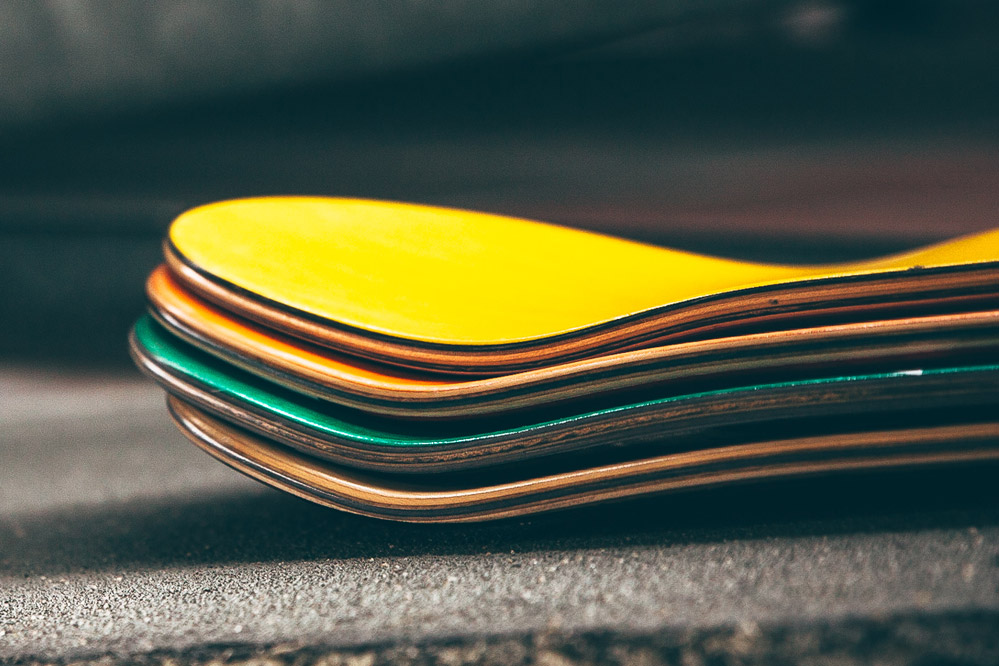
 Don’t feel like reading all that? Get all important information about skateboard decks in this video!
Don’t feel like reading all that? Get all important information about skateboard decks in this video!